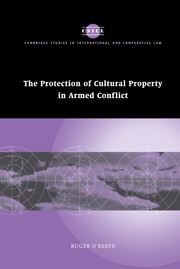Book contents
- Frontmatter
- Contents
- Acknowledgements
- Table of cases
- Table of treaties and other international instruments
- List of abbreviations
- Prologue
- 1 From the high Renaissance to the Hague Rules
- 2 1914 to 1954
- 3 The 1954 Hague Convention and First Hague Protocol
- 4 The 1977 Additional Protocols
- 5 The 1999 Second Hague Protocol
- 6 Other relevant bodies of law
- Epilogue
- Bibliography
- Index
- CAMBRIDGE STUDIES IN INTERNATIONAL AND COMPARATIVE LAW
3 - The 1954 Hague Convention and First Hague Protocol
Published online by Cambridge University Press: 28 July 2009
- Frontmatter
- Contents
- Acknowledgements
- Table of cases
- Table of treaties and other international instruments
- List of abbreviations
- Prologue
- 1 From the high Renaissance to the Hague Rules
- 2 1914 to 1954
- 3 The 1954 Hague Convention and First Hague Protocol
- 4 The 1977 Additional Protocols
- 5 The 1999 Second Hague Protocol
- 6 Other relevant bodies of law
- Epilogue
- Bibliography
- Index
- CAMBRIDGE STUDIES IN INTERNATIONAL AND COMPARATIVE LAW
Summary
In 1946, as heir to the ICIC, the United Nations Educational, Scientific and Cultural Organisation (UNESCO) was established as a specialised agency of the new United Nations Organisation. Given its constitutional mandate to maintain, increase and diffuse knowledge by ‘assuring the conservation and protection of the world's inheritance of books, works of art and monuments of history and science, and recommending to the nations concerned the necessary international conventions’, it seemed natural that it should move quickly to revive the idea of a multilateral agreement on the protection of monuments and artworks in war. In 1949, UNESCO's General Conference instructed the Director-General of the Organisation to report to it the following year on ‘measures suitable for ensuring the co-operation of interested States in the protection, preservation and restoration of antiquities, monuments and historic sites’, giving particular attention ‘to arrangements for the protection of such monuments, as well as to the protection of all objects of cultural value, particularly those kept in museums, libraries and archives, against the probable consequences of armed conflict’. In pursuance of this mandate, the Director-General convened a meeting of experts in 1950, followed by two more in succeeding years, to prepare a draft convention on the protection of cultural property in the event of armed conflict. Working from the OIM draft, progress towards a UNESCO draft convention was relatively swift, and, fifteen years after its earlier invitation had been thwarted, the Netherlands government eventually invited diplomatic representatives to an Intergovernmental Conference on the Protection of Cultural Property in the Event of Armed Conflict, which met at The Hague from 21 April to 14 May 1954.
- Type
- Chapter
- Information
- The Protection of Cultural Property in Armed Conflict , pp. 92 - 201Publisher: Cambridge University PressPrint publication year: 2006

